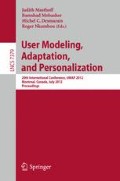Abstract
The study goal was to evaluate whether Electroencephalography (EEG) estimates of attention and cognitive workload captured as students solved math problems could be used to predict success or failure at solving the problems. Students (N = 16) solved a series of SAT math problems while wearing an EEG headset that generated estimates of sustained attention and cognitive workload each second. Students also reported on their level of frustration and the perceived difficulty of each problem. Results from a Support Vector Machine (SVM) training indicated that problem outcomes could be correctly predicted from the combination of attention and workload signals at rates better than chance. EEG data were also correlated with students’ self-report of problem difficulty. Findings suggest that relatively non-intrusive EEG technologies could be used to improve the efficacy of tutoring systems.
Access this chapter
Tax calculation will be finalised at checkout
Purchases are for personal use only
Preview
Unable to display preview. Download preview PDF.
References
Advanced Brain Monitoring, BAlert X10 (2011), http://www.b-alert.com/x10.html
Arroyo, I., Mehranian, H., W.B.P.: Effort-based Tutoring: An Empirical Approach to Intelligent Tutoring. In: Baker, R.S.J.d., M. A. P. P. J. E. (eds.), Proceedings of the 3rd International Conference on Educational Data Mining (2010)
Arroyo, I., Cooper, D.G., Burleson, W., Woolf, B.P., Muldner, K., Christopherson, R.: Emotion Sensors Go To School. In: Proceeding of the 2009 Conference on Artificial Intelligence in Education, pp. 17–24. IOS Press (2009)
Baker, R.S.J.d., Walonoski, J., Heffernan, N., Roll, I., Corbett, A., Koedinger, K.: Why students engage in gaming the system behavior in interactive learning environments. Journal of Interactive Learning Research 19, 185–224 (2008)
Beal, C., Mitra, S., Cohen, P.R.: Modeling learning patterns of students with a tutoring system using Hidden Markov Models. In: Proceeding of the 2007 Conference on Artificial Intelligence in Education, pp. 238–245. IOS Press (2007)
Berka, C., Levendowski, D.J., Lumicao, M.N., Yau, A., Davis, G., Zivkovic, V.T., Olmstead, R.E., Tremoulet, P.D., Craven, P.L.: EEG correlates of task engagement and mental workload in vigilance, learning, and memory tasks. Aviat Space Environ. Med. 78(5 suppl.), B231–B244 (2007)
Berka, C., Levendowski, D.J., Ramsey, C.K., Davis, G., Lumicao, M.N., Stanney, K., Reeves, L., Regli, S.H., Tremoulet, P.D., Stibler, K.: Evaluation of an EEG workload model in an Aegis simulation environment. In: Caldwell, J.A., Wesensten, N.J. (eds.) Society of Photo-Optical Instrumentation Engineers (SPIE) Conference Series, vol. 5797, pp. 90–99 (2005)
Chaouachi, M., Jraidi, I., Frasson, C.: Modeling Mental Workload Using EEG Features for Intelligent Systems. In: Konstan, J.A., Conejo, R., Marzo, J.L., Oliver, N. (eds.) UMAP 2011. LNCS, vol. 6787, pp. 50–61. Springer, Heidelberg (2011)
Fan, R.-E., Chen, P.-H., Lin, C.-J.: Working Set Selection Using Second Order Information for Training Support Vector Machines. J. Mach. Learn. Res., JMLR.org 6, 1889–1918 (2005)
Fincham J.M., Anderson J.R., B.S., J., F., Using Neural Imaging and Cognitive Modeling to Infer Mental States while Using an Intelligent Tutoring System. In: Baker, R.S.J.d., M. A. P. P. J. (eds.) Proceedings of the 3rd International Conference on Educational Data Mining, vol. 3, pp. 51–60 (2010)
Johns, J., Woolf, B.P.: A dynamic mixture model to predict student motivation and proficiency. In: Proceedings of the AAAI. IOS Press, Boston MA (2006)
Kapoor, A., Burleson, W., Picard, R.W.: Automatic prediction of frustration. International Journal of Human-Computer Studies 65(8), 724–736 (2007)
Mostow, J., Chang, K.-M., Nelson, J.: Toward Exploiting EEG Input in a Reading Tutor. In: Biswas, G., Bull, S., Kay, J., Mitrovic, A. (eds.) AIED 2011. LNCS, vol. 6738, pp. 230–237. Springer, Heidelberg (2011)
Niedermeyer, Ernst, D.S.F.H.L., Ovid Technologies, I.: Electroencephalography Basic Principles, Clinical Applications, and Related Fields, p. 140. Lippincott Williams & Wilkin, Philadelphia (2005)
Poythress, M., et al.: Correlation between Expected Workload and EEG Indices of Cognitive Workload and Task Engagement. Augmented Cognition: Past, Present and Future, 32–44 (2006)
Quinlan, J.R.: Induction of Decision Trees. Machine Learning 1, 81–106 (1986)
Stevens, R.H., Galloway, T., Berka, C., Johnson, R., Sprang, M.: Assessing students’ mental representations of complex problem spaces with EEG technologies. In: Proceedings of the 52nd Annual Meeting of the Human Factors and Ergonomic Society, New York, NY (2008)
Author information
Authors and Affiliations
Editor information
Editors and Affiliations
Rights and permissions
Copyright information
© 2012 Springer-Verlag Berlin Heidelberg
About this paper
Cite this paper
Cirett Galán, F., Beal, C.R. (2012). EEG Estimates of Engagement and Cognitive Workload Predict Math Problem Solving Outcomes. In: Masthoff, J., Mobasher, B., Desmarais, M.C., Nkambou, R. (eds) User Modeling, Adaptation, and Personalization. UMAP 2012. Lecture Notes in Computer Science, vol 7379. Springer, Berlin, Heidelberg. https://doi.org/10.1007/978-3-642-31454-4_5
Download citation
DOI: https://doi.org/10.1007/978-3-642-31454-4_5
Publisher Name: Springer, Berlin, Heidelberg
Print ISBN: 978-3-642-31453-7
Online ISBN: 978-3-642-31454-4
eBook Packages: Computer ScienceComputer Science (R0)

